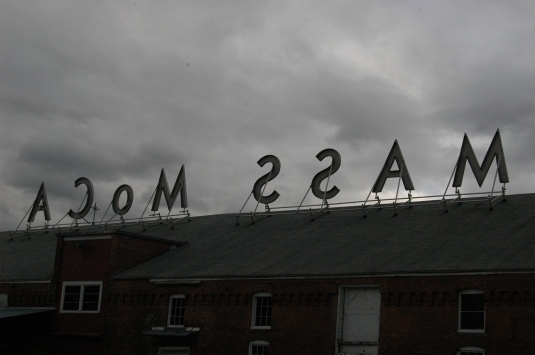I suppose I had noticed the names and dates at various times when I bought a deli sandwich or a cup of coffee or some totally evil pastry that came in one of those small paper bags. A quick glance at the bottom of the bag at the name Maribel or Raymond or Mary, Lucita or Juan or sometimes a first initial and last name like L. Vu. And a date. While I had noticed the names I hadn’t thought too much about them until I went to an exhibit at Mass MoCA with my friend Pat, after driving through the autumn New England countryside from Saratoga to North Adams.
Mass MoCA, the Massachusetts Museum of Contemporary Art,  is housed in an enormous old brick manufacturing building, with huge galleries, including room after room of Sol Lewitt’s wall drawings of bold strips of color and myriads of intersecting pencil lines. The collection of paper bags by artist Mary Lum was part of an exhibit called The Workers that chronicled the connection of the people who operated the machines with the products and process, the banality and pride of manufacturing. The Mass MoCA blog states: “Tinker Tailor Soldier Sailor features an assemblage of hand-torn paper bag fragments which the artist has been collecting for nearly two decades. Each of the pieces – torn from a multitude of bag bottoms — is stamped with the name of the individual who made the bag or oversaw its production and quality on the assembly line. A detail easy to miss, each name reminds us of the human element behind industrialized production and the objects we use on a daily basis.” Mary Lum stated that the piece was about “the idea that a human being is taking responsibility for the acts of a machine, and the double purpose of being named, pride and quality control.”
is housed in an enormous old brick manufacturing building, with huge galleries, including room after room of Sol Lewitt’s wall drawings of bold strips of color and myriads of intersecting pencil lines. The collection of paper bags by artist Mary Lum was part of an exhibit called The Workers that chronicled the connection of the people who operated the machines with the products and process, the banality and pride of manufacturing. The Mass MoCA blog states: “Tinker Tailor Soldier Sailor features an assemblage of hand-torn paper bag fragments which the artist has been collecting for nearly two decades. Each of the pieces – torn from a multitude of bag bottoms — is stamped with the name of the individual who made the bag or oversaw its production and quality on the assembly line. A detail easy to miss, each name reminds us of the human element behind industrialized production and the objects we use on a daily basis.” Mary Lum stated that the piece was about “the idea that a human being is taking responsibility for the acts of a machine, and the double purpose of being named, pride and quality control.”
(To read more about the exhibit: Mass MoCA The Workers May 29, 2011 to April 14, 2012 http://blog.massmoca.org/2011/08/03/artist-spotlight-on-mary-lum/)
The exhibit was a reminder of how powerful our names are. We sign checks, our tax returns, and all manner of legal documents that commit us, connect us, bind us and sometimes separate us. We sign our names on little notes to loved ones, birthday wishes and post cards from faraway places; we sign our passports. And for those of us in health care, our names verify notes in patient files, prescriptions, care plans. When I was in the pre-op room before my ankle surgery on February 7, 2013, my surgeon, according to surgical protocols, initialed my right leg. Tragic surgical errors of operating on the wrong person, at the wrong site, with the wrong procedure have resulted in the need for checklists of the process of identification and accountability to assure safety and quality of care. On the website of the American Academy of Orthopedic Surgeons, the list is as follows:
Pre-operative verification process
- Hospitals should identify the methodology of pre-procedure verification and site marking based on their own circumstances. Verification of the correct person, procedure and site should occur with the patient awake and aware, if possible:
- At the time of surgery/procedure is scheduled.
- At the time of pre-admission and testing
- At the time of admission or entry into the facility.
- Anytime the responsibility for care of the patient is transferred to another caregiver.
- Before the patient leaves the preoperative area or enters the procedure/surgical room.
http://www3.aaos.org/member/safety/guidelines.cfm
An article in the Chicago Sun Times noted that: “Even seemingly minor mistakes such as using an unapproved pen to mark the site, resulting in the ink being washed away before surgery, can open the door for a wrong-site error,” Joint Commission President Dr. Mark R. Chassin said. Chicago Sun Times July 4, 2011
The surgical site can be marked with a line where the incision will be made, or with “yes,” with an X, or with the surgeon’s initials. So my surgeon, Adam Becker, MD, of Englewood Orthopedics, marked my right leg with his initials, I am happy to say. This might just be the protocol of Englewood Hospital, but to me it meant he was not only marking the site so there was no doubt about which ankle needed the incision, titanium plate and six screws, he was taking ownership of that ankle. The procedure, the responsibility, the accountability and the quality of my ankle repair belonged to him. I must say about a month after the surgery, after the massive wrappings and ace bandages which were transmogrified into a bright blue hard cast were all removed and the stitches came out and I was able to (finally!!!!) take a bath, I was a little sad to see the Sharpied AB on my skin float away into the warm water and bubbles. My ankle was back to being my sole possession and responsibility although I will always appreciate Dr. Becker’s kindness, skill and his accountability.
Accountability is what it is all about in health care now linking the reduction in costs, with the increase in quality outcomes and patient satisfaction. The triple mantra of right price, right place, right services, supports the structures of Accountable Care Organizations, under the Affordable Care Act. Believe me, everyone out there providing health care wants to be an Accountable Care Organization because that’s where the government money is going. Being Accountable is lucrative and the big health care providers and insurance companies are all grappling with the cost/quality/satisfaction matrix. There’s a great website http://www.accountablecarefacts.org/facts/ that brings together all of the research and expertise that accountability in health care is generating in policy and practice. Important information for all of us care providers and patients.
And yet in this grand shift of corporate health accountability I think the change will be in the commitment of individuals to their own responsibility and pride in a job well done, of individual caring within a structure of accountability…kind of like people putting their names on paper bags. Atul Gawande, MD, my second favorite surgeon, has focused on this in his Checklist Manifesto: How to Get Things Right http://blog.ej4.com/wp-content/uploads/2012/06/The-Checklist-Manifesto.pdf In the environment of massive knowledge and expertise he maintains that true accountability and quality is in the commitment of each individual checking off their box on the check list. I did this, I am responsible for this, I care about this, I am committed to the best of this, I check this off and put my name on it. I own it. This is my paper bag, my ankle, my responsibility and pride, my own name, my humanity.
At another museum, The Hirschhorn on the Mall in Washington, DC, which I visited last November with my friend Heller An and her daughter Karen, there was an exhibit of the work of Ai Weiwei, the brilliant Chinese artist, philosopher, political dissident and human right activist. There were his amazing Circle of Animals Zodiac Heads around the reflection pool, the back pack sculpture representing the 5385 students who died in the 2008 Sichuan earthquake, and the bold black on white statements like, “When was the last time you laughed?” And on one wall the testimony to each person’s accountability, rights, pride, commitment to quality, to their individual spirit and value, in health care and all care, caregiver or care recipient, individual human caring, kindness and virtue:
A name is the first and final marker of individual rights, one fixed part of the ever-changing human world. A name is the most basic characteristic of our human rights: no matter how poor or rich, all living people have a name, and it is endowed with good wishes, the expectant blessings of kindness, and virtue. Ai Weiwei
Karel Rose Amaranth
